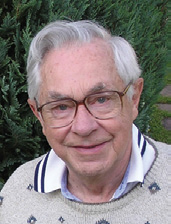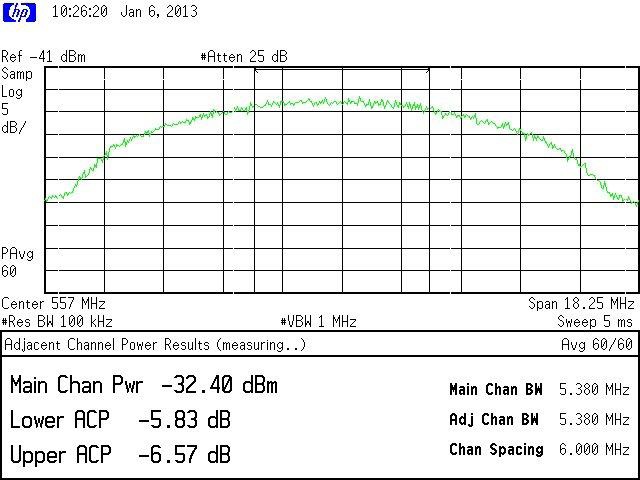DTV Interference and Its Mitigation After Repacking

Charles W. Rhodes
Last month, at the IEEE International Conference on Consumer Electronics, my colleagues and I presented measurements of the desensitization of NTIA-approved ATSC converter boxes which are in approximately 30 million U.S. homes to view over-the-air TV.
We found that one undesired ATSC signal eight channels above the desired channel desensitized these converters by 2.2 dB when the undesired (U) signal was received at –20 dBm. The desensitization was about 10 dB if there was a pair of U signals on Chs. 8, and 16 MHz above the desired signal. We know that the minimum usable ATSC signal requires a signal-to-noise power ratio of at least 15.2 dB and that the receiver-generated noise within the desired channel is about –99.2 dBm so the noise-limited sensitivity of an ATSC receiver is –84 dBm.
This works out to requiring a minimum field strength of 40.8 dB above 1 microvolt/meter at the edge of your noise limited coverage. If there is interference, then the minimum required field strength increases and your actual coverage decreases. This increase of the minimum usable ATSC signal due to interference is called desensitization.
Three points should be obvious:
• With interference, your audience must decrease below what it is estimated to be based on noise-limited coverage;
• Desensitization after the FCC repacks the UHF band is not good, but some is inevitable; and
The professional video industry's #1 source for news, trends and product and tech information. Sign up below.
• Interference from two U signals would be much greater than with one U signal, and I believe that two or more strong interferers will be more frequently encountered after repacking.
ALTERING DESENSITIZATION
How can this second U signal change the desensitization so much? With one U signal, some desensitization results from the RF gain of receivers being automatically decreased by the action of the wideband RF automatic gain control (AGC) in most, if not all, DTV receivers.

Fig 1: Spectrum Plot. Spectrum of third order distortion products centered in Channel 28. The noise power in each adjacent channel is only 6 dB lower than in the center channel. With two U signals, third-order intermodulation products (IM3) can be generated in the receiver. These IM3 may fall in the desired channel. If we have U signals on Channels 30 and 38 these IM3 fall in Channels 22 and 46. IM3 falling in a desired channel acts like noise, which adds to the receiver-generated noise, thus reducing the signal-to-noise ratio. This is how a second U signal far from the desired signal can ruin your day.
More trouble lies ahead. Perhaps your channel (after repacking) is Channel 46. The noise power (IM3) falling in Channel 46 is equal to that falling in another other channel (28) assuming the two U signals are received at the same power. In other words, a viewer has two chances of losing coverage due to these two signals. Each of these IM3 occupies three consecutive channels as shown in Fig. 1.
In this spectrum plot, I’ve used the ACP measurement mode of my spectrum analyzer. The main channel power is given in dBm while the noise power in an adjacent channel is given in dB below the noise power in the main channel. This noise power difference is about 6 dB. So now we find that Channels 27 and 29 and also Channels 45 and 47 may reduce SNR. The second U signal can cause desensitization of up to six channels, one of which might be yours.
I was amazed at the width of this problem in megahertz.
Steve Martin at the FCC Laboratory was the first to report this problem in the December 2010 issue of IEEE Transactions on Broadcasting. He made measurements with two U signals offset by ± 2, 3, 5, and 10 channels. We did tests with + 2, 3, 4, 5, 6, 7, 8, 9, and 10. His results demonstrated desensitization, even from a U signal 60 MHz from the desired signal. He also showed that both + and – offsets produced about the same result. We confined our efforts to testing all the positive offsets known to cause interference.
Given two U signals of the form N+K and N+2K, the IM3 products are centered in channels N and N+3K (K is an integer). K can be greater than 10 and have an effect on DTV reception. K= 1 was not tested by either Martin or my colleagues and I, but I regard K=1 as a terrific threat. I hope to prove this soon.
INTERFERENCE MITIGATION
Here is how this interference could be prevented by the FCC. If in a given community, where an incumbent broadcaster is on channel N, allow a station on channel N+20, but prohibit use of N+10; allow N+16, but prohibit use of N+8; allow N+6 but prohibit use of N+3 and allow N+4 but prohibit use of N+2. The same would apply to the use of channels below N. For example, allow channel N–20, but prohibit N–10, etc.
This should result in a substantial decrease in desensitization. The process should allow high number offsets first, not the lowest offset first, because the desensitization by one U signal on N ±2 is 23 dB, while for N+10, it is only 8.4 dB.
So you see, the FCC can solve this problem for broadcasters. In fact, the FCC is obligated to minimize the loss of broadcast coverage to the extent that this is possible. And I’ve shown one way to do this. That is your good news, but of course you know there is always bad news.
Our tests showed that the double-conversion tuners (DCT) tested were more vulnerable to interference than the converter boxes with a single-conversion tuner (SCT). The DCTs give a desensitization up to 29.9 dB compared to the SCTs with up to 8.4 dB.
No one knows what percentage of the DTV receiving devices out there have DCTs, but in my laboratory there were five out of 26 converter boxes with double-conversion tuners. Having said all this, I should note that the DCT units outperformed the SCT units in rejection of image taboos N+14 and N+15.
As this column has recently suggested, perhaps with repacking, the government should replace converter boxes that have failed as a result of the repacking with certified single-conversion converter boxes. Perhaps the government should also require better image rejection too in these single-conversion converter boxes.
Stay tuned.
Charles Rhodes is a consultant in the field of television broadcast technologies and planning. He can be reached via email atcwr@bootit.com.
